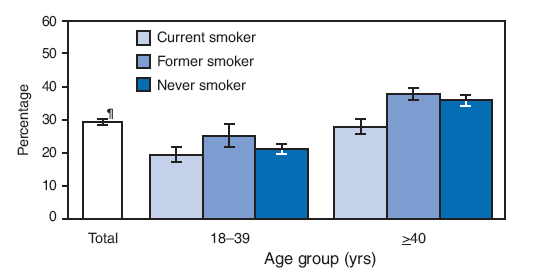Persons using assistive technology might not be able to fully access information in this file. For assistance, please send e-mail to: mmwrq@cdc.gov. Type 508 Accommodation and the title of the report in the subject line of e-mail.
 |
|
|
|
|
|
|
| ||||||||||
|
|
|
|
|
|
|
||||
| ||||||||||
|
|
|
|
|
Persons using assistive technology might not be able to fully access information in this file. For assistance, please send e-mail to: mmwrq@cdc.gov. Type 508 Accommodation and the title of the report in the subject line of e-mail. QuickStats: Percentage of Adults Aged ≥18 Years Who Have Ever Had An Oral Cancer Examination,* by Smoking Status and Age Group† --- National Health Interview Survey, United States, 2008§
* Based on affirmative responses to either of the following questions: "Have you ever had an exam for oral cancer in which the doctor, dentist, or other health professional pulls on your tongue, sometimes with gauze wrapped around it, and feels under the tongue and inside the cheeks?" or "Have you ever had an exam for oral cancer in which the doctor, dentist, or other health professional feels your neck?" † Based on responses to the following questions: "Have you smoked at least 100 cigarettes in your entire life?" and "Do you now smoke cigarettes every day, some days, or not at all?" Lifetime smoking status was defined as follows: Never smoker (never smoked at all or smoked less than 100 cigarettes in lifetime); former smoker (smoked at least 100 cigarettes in lifetime but not currently smoking); and current smoker (smoked at least 100 cigarettes in lifetime and currently smoking). § Estimates are based on household interviews of a sample of the civilian, noninstitutionalized U.S. population. ¶ 95% confidence interval. In 2008, 29.4% of adults aged ≥18 years had ever had an oral cancer examination in which a doctor, dentist, or other health professional pulled on their tongue or palpated their neck. Adults aged ≥40 years were more likely to have ever had an examination than those aged 18--39 years, regardless of smoking status. Those most at risk for oral cancer (current smokers aged ≥40 years) were less likely to have ever had an oral cancer examination than former smokers or never smokers. SOURCE: National Health Interview Survey, 2008 data. Available at http://www.cdc.gov/nchs/nhis.htm. Alternative Text: The figure above shows the percentage of adults aged ≥18 years who have ever had an oral cancer examination, by smoking status and age group from the 2008 National Health Interview Survey. In 2008, 29.4% of adults aged ≥18 years had ever had an oral cancer examination in which a doctor, dentist, or other health professional pulled on their tongue or palpated their neck. Adults aged ≥40 years were more likely to have ever had an examination than those aged 18-39 years, regardless of smoking status. Those most at risk for oral cancer (current smokers aged ≥40 years) were less likely to have ever had an oral cancer examination than former smokers or never smokers.
All MMWR HTML versions of articles are electronic conversions from typeset documents. This conversion might result in character translation or format errors in the HTML version. Users are referred to the electronic PDF version (http://www.cdc.gov/mmwr) and/or the original MMWR paper copy for printable versions of official text, figures, and tables. An original paper copy of this issue can be obtained from the Superintendent of Documents, U.S. Government Printing Office (GPO), Washington, DC 20402-9371; telephone: (202) 512-1800. Contact GPO for current prices. **Questions or messages regarding errors in formatting should be addressed to mmwrq@cdc.gov.Date last reviewed: 9/17/2009 |
|||||||||
|